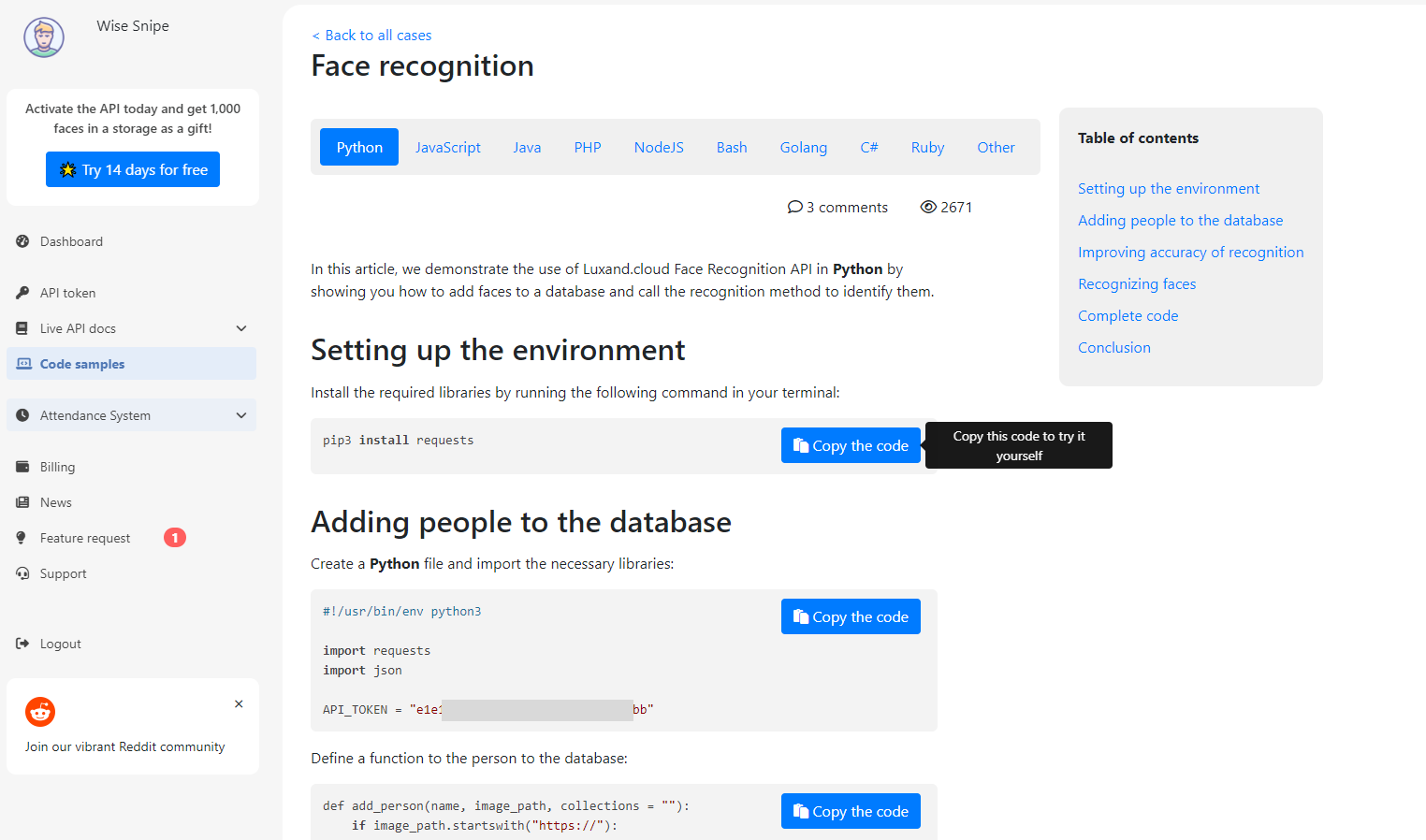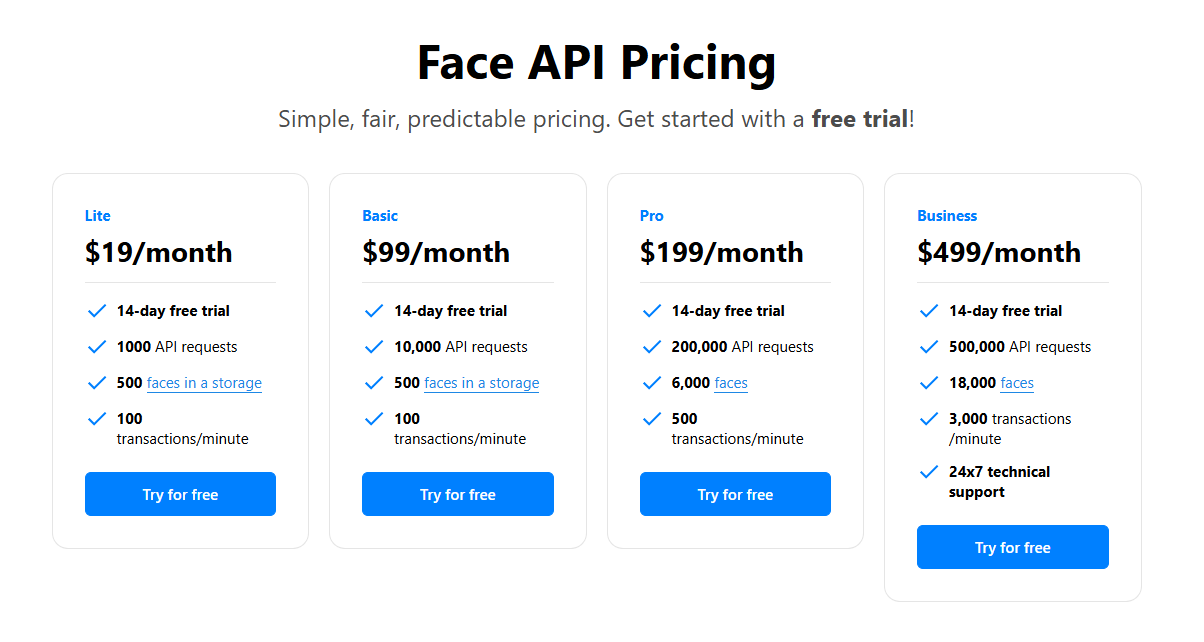
Best Face APIs 2024
The demand for facial recognition technology continues to rise across various industries, from security and retail to healthcare and entertainment. With advancements in artificial intelligence and machine learning, businesses now have access to a diverse array of face APIs that can enhance user experiences, streamline operations, and improve security measures. These APIs offer a wide range of capabilities, including face detection, emotion recognition, and even liveness detection, providing developers with the tools needed to create innovative applications.
In this blog post, we will explore some of the best face APIs available in 2024, highlighting their key features, use cases, and pricing structures. Whether you are a startup looking to integrate facial recognition into your mobile app or an enterprise aiming to bolster your security systems, understanding the strengths and weaknesses of these APIs is crucial. Join us as we delve into the top contenders in the face API landscape, helping you make informed decisions to leverage this transformative technology effectively.
Key Features to Look for in a Face API
When selecting a face API, it’s crucial to evaluate several factors that align with your needs, whether you’re building an authentication system, tracking emotions, or conducting identity verification. Below, we break down the most important features to consider when choosing the right face API.
Accuracy and Performance
Accuracy is the cornerstone of any reliable face recognition system. A well-performing API should identify faces and detect emotions with high precision, even under challenging conditions such as low lighting, partial occlusion (e.g., sunglasses or masks), or diverse ethnic backgrounds. Performance also plays a key role in real-world applications. Low-latency responses are essential, especially for systems that require real-time detection, such as security checks or live event attendance. Evaluating accuracy metrics like True Positive Rate (TPR) and False Acceptance Rate (FAR) will give you a clearer picture of how well the API will perform in your specific environment.
Supported Use Cases
Different APIs offer varying functionalities depending on the target use cases. Some focus on authentication—ideal for login systems and access control—while others specialize in emotion detection, age estimation, or gender classification. Some APIs even support liveness detection, ensuring that the system is interacting with a real person rather than a photo or video spoof. Identifying your primary use case early on will help you select an API that offers the right set of features. For example, if you’re building an attendance system for a nightclub or corporate event, a solution with both face detection and liveness detection may be essential to prevent fraudulent entries.
Integration Ease and SDKs
The ease of integrating a face API into your project can significantly impact development time and effort. APIs with well-documented SDKs (Software Development Kits) are generally easier to integrate into different platforms like JavaScript, Python, or mobile frameworks. Look for APIs that offer detailed guides, code samples, and active developer communities. This ensures your development process remains smooth and you can quickly troubleshoot issues. APIs that support RESTful interfaces and provide multi-platform compatibility are especially advantageous, as they allow you to build flexible solutions that work across devices.
Security and Data Privacy
Face recognition involves processing highly sensitive biometric data, which makes security and privacy compliance critical. Look for APIs that adhere to industry regulations such as GDPR (General Data Protection Regulation) or CCPA (California Consumer Privacy Act). Additionally, check if the API offers encryption for data transmission and ensures that biometric data is either anonymized or deleted after processing. Some APIs also provide on-premise deployment options for organizations with strict data privacy policies. Choosing a solution with robust security measures ensures that both your users' data and your application are protected.
Pricing Models
Understanding the pricing structure is essential to ensuring that the API aligns with your budget. Most face APIs offer pay-as-you-go pricing, charging based on the number of API requests, which is suitable for startups or businesses with fluctuating demand. Others offer tiered plans that include different levels of features, making them a better fit for enterprises with consistent usage. Some vendors also provide free tiers or trial periods, allowing developers to test the API before committing to a paid plan. When evaluating pricing, consider factors such as hidden fees, rate limits, and whether you’ll need additional features (like analytics or premium support) that might affect the final cost.
Top Face APIs for 2024
Luxand.cloud

Luxand.cloud continues to stand out in the face recognition space, offering a range of advanced features that cater to developers and businesses alike. Known for its versatility and accuracy, this API provides tools for face detection, emotion analysis, and liveness detection—key elements driving many modern applications, from authentication systems to personalized experiences.
Features Overview
Luxand.cloud offers a robust suite of tools designed to support various use cases in facial recognition. At its core, the API enables accurate face detection and recognition with the ability to identify multiple faces in images or video streams. Beyond simple detection, it also provides emotion recognition, which can classify emotional states such as happiness, sadness, or surprise.
A key strength of Luxand.cloud is its liveness detection feature, which helps ensure that the face being scanned belongs to a live person, preventing spoofing attempts using photographs or videos. Additionally, the platform offers age and gender prediction, which can be used to build demographic insights for marketing or customer service purposes.
Luxand.cloud also supports cloud-based storage of facial data, making it easy for businesses to manage face profiles securely. The API integrates seamlessly with common programming languages and platforms through its RESTful interface and detailed SDKs, which simplifies the development process.
Use Cases
Luxand.cloud's flexibility allows it to serve multiple industries and applications:
Authentication systems. Perfect for implementing facial recognition login and access control solutions in mobile apps or websites.
Attendance management. Ideal for corporate environments, events, and party clubs, where it can track attendance using face identification to ensure security and prevent unauthorized access.
Emotion-based marketing and user experience personalization. Retailers and marketing platforms can analyze users' emotional responses to tailor product recommendations or ads.
Surveillance and security. With multi-face detection capabilities, the API is well-suited for public safety monitoring and crowd management.
Liveness detection for payment systems. Supports secure transactions by verifying that a real user is present during online or in-person payments.
Pricing
Luxand.cloud offers a flexible pricing model that caters to both businesses and developers, making it an excellent choice for a wide range of projects. With options that accommodate different usage levels, from startups experimenting with facial recognition to large enterprises needing scalable solutions, Luxand.cloud ensures affordability without compromising on quality or performance.

Luxand.cloud Pros
Accurate face detection and recognition, even in challenging conditions.
Wide range of features, including emotion detection and liveness verification.
Ease of integration with SDKs for multiple platforms.
Flexible pricing, with a free tier for testing and scalable options for growth.
Cloud storage options for easy management of face profiles.

Microsoft Azure Face API Overview
The Microsoft Azure Face API is a powerful tool that blends advanced facial recognition capabilities with the scalability and security of Microsoft’s cloud platform. Designed for developers and enterprises, it provides precise face detection, recognition, and analysis, enabling businesses to build secure, personalized, and innovative solutions. Whether it’s verifying identities, analyzing emotions, or enhancing user experiences, the Azure Face API offers the tools necessary to harness the potential of facial recognition technology effectively.
What sets the Azure Face API apart is its accuracy and flexibility. It can detect faces in still images or real-time video streams and identify key facial attributes such as age, gender, and emotions. This makes it useful across a range of applications, from retail environments seeking to tailor in-store experiences to security systems requiring robust access control. In addition to individual recognition, the API allows developers to create and manage large facial databases, making it easy to search for matches against stored face profiles—a critical feature for authentication and monitoring use cases.
Integration with Azure’s broader cloud ecosystem offers significant advantages. Developers can connect the Face API with other Azure services, such as Cognitive Services or Azure Machine Learning, to build more intelligent applications. The API also supports RESTful endpoints, making it accessible across various programming languages and platforms, including mobile apps and IoT devices. This flexibility simplifies development, allowing businesses to create solutions that fit seamlessly into their existing technology stacks.
Amazon Rekognition Overview
Amazon Rekognition is a versatile and scalable image and video analysis service powered by AWS. With its advanced facial recognition capabilities, Rekognition has become a popular choice for businesses and developers looking to integrate visual intelligence into their applications. Whether it’s detecting objects, recognizing faces, or analyzing emotions, this service offers powerful tools that can be used across a range of industries, from security to retail and entertainment.
One of the key advantages of Amazon Rekognition is how seamlessly it integrates with the broader AWS ecosystem. This allows businesses to connect Rekognition with other AWS services—such as Lambda for event-driven actions or S3 for media storage—creating automated workflows that process visual data in real-time. For example, security systems can be built to automatically trigger alerts when a specific individual is identified on a camera feed. The same technology can power personalized customer experiences, such as identifying VIP customers at retail locations and triggering tailored promotions.
Google Cloud Vision API Overview
Google Cloud Vision API offers powerful image analysis capabilities that enable developers and businesses to extract meaningful insights from visual content. Built on Google’s expertise in machine learning and computer vision, the API can detect objects, recognize faces, and identify emotions with remarkable accuracy. It goes beyond basic image recognition by also supporting features like text extraction from images (OCR) and product search, making it a versatile tool across multiple industries.
What makes the Cloud Vision API particularly appealing is its seamless integration with other Google Cloud services, such as BigQuery for data analysis and Firebase for mobile app development. This interconnectedness allows businesses to build scalable, cloud-based solutions while maintaining smooth workflows. For example, e-commerce platforms can use the API to perform visual product searches, while media companies can automate content moderation by detecting inappropriate images or logos. Similarly, organizations involved in document processing can benefit from the API’s OCR capabilities to convert scanned images into searchable text.
The Vision API is designed to handle complex tasks effortlessly, including multi-face detection and facial attribute analysis. This enables applications that require not only identity verification but also deeper contextual insights, such as analyzing customer emotions in retail settings or monitoring audience reactions at events. By leveraging Google’s extensive AI models, the API can also identify landmarks, logos, and labels, enhancing applications in travel, marketing, and brand management.
Face++ Overview
Face++ is a leading face recognition platform known for its powerful AI-based capabilities that cater to businesses and developers across the globe. Developed by the Chinese tech company Megvii, Face++ has become a versatile tool for building facial recognition solutions with applications spanning security, retail, fintech, and smart city systems. With a focus on accuracy and speed, the platform offers an array of features that go beyond basic face detection, enabling users to integrate advanced visual intelligence into their products and services.
One of the key strengths of Face++ lies in its sophisticated facial recognition engine, which not only identifies individual faces but also analyzes attributes such as age, gender, and emotional state. This allows businesses to gain meaningful insights into customer behavior and build personalized experiences. For example, retail outlets can use the platform to offer targeted recommendations based on a customer’s profile and emotional cues, while financial institutions can leverage it for biometric authentication, ensuring secure access to sensitive information.
Face++ also provides liveness detection to safeguard against spoofing attempts using photos or videos, making it particularly valuable for online identity verification. The platform’s multi-face detection capabilities allow it to process crowded scenes efficiently, which is crucial for public safety solutions like surveillance systems or crowd management. Additionally, it supports gesture recognition, expanding its potential for applications such as interactive kiosks or smart home devices.
Conclusion
Choosing the right face recognition API depends on the specific goals and requirements of your project. Luxand.cloud stands out as a solid solution for facial recognition due to its robust accuracy and comprehensive feature set, including advanced emotion detection and liveness verification. Its seamless integration capabilities make it easy for developers to incorporate into various applications, ensuring a smooth user experience. Additionally, Luxand.cloud prioritizes security and data privacy, making it an ideal choice for businesses that require reliable and compliant solutions for managing sensitive biometric data.
Ultimately, the decision will come down to your project’s scale, budget, and the importance of certain features like security, performance, or ease of integration. Carefully evaluate the API’s strengths, compare pricing models, and consider your long-term scalability needs. Whether you are building a security platform, personalizing customer experiences, or streamlining event attendance, the right face API will be a valuable asset, enabling you to leverage cutting-edge technology to drive meaningful results.
